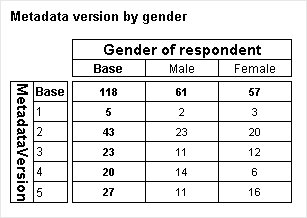Working with versions
As a survey progresses, changes are sometimes made to the questionnaire. For example, questions and categories may be added and deleted. Typically a new version is created in the metadata each time a change is made to the questionnaire and each version corresponds to a variation of the questionnaire used for some of the interviews.
When you load a data set that contains more than one version, all of the versions are combined to form a superset (sometimes called a superversion). This means that all of the variables and categories from all of the versions are available. When there is a conflict between, for example, a text in one or more of the versions, the more recent versions generally take precedence over the older versions. However the order of questions and categories is always taken from the most recent version.
Case data that is collected using UNICOM Intelligence Interviewer - Server Admin shares the name of the version that was used to collect it. The version name is stored in a system variable called DataCollection.MetadataVersionNumber . This means that it is easy to filter UNICOM Intelligence Interviewer - Server Admin case data based on the version used to collect it. Typically you would create the filter as a global filter, which means that it will be applied to all tables automatically.
Note In data collected using tools other than UNICOM Intelligence Interviewer - Server Admin, the DataCollection.MetadataVersionNumber system variable may not store the name of the version, depending on how the data was set up.
The DataCollection.MetadataVersion derived categorical system variable automatically contains a category for each version that is loaded. The categories have names of the form Ver_ n, where n is the version name. This variable provides an alternative way of filtering the case data on the version of the metadata used to collect it.
You can also use this variable to tabulate variables by the version. For example, here is a table (created using the Short Drinks sample data) that has this variable on the side axis and the Gender variable on the top:
Table showing metadata version by gender
See also

